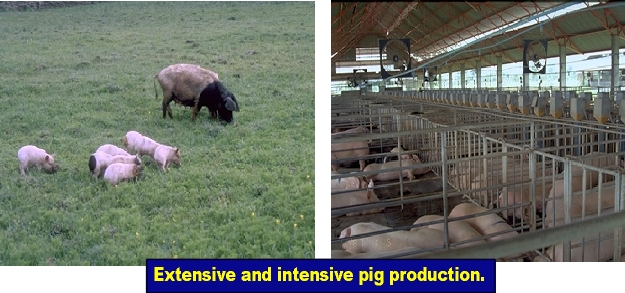The system of rearing animals, including pigs, can be classified into two groups. The extensive method and the intensive method.
The first method is usually practiced by peasants or small-scale producers while the second can only be practiced by Large-scale or commercial producers.
Extensive System
These can also be called peasants or small-scale producers.
Pigs kept under this system are usually few. They roam from place to place in search of food.
In this system, native or upgraded strains of pigs are predominantly used because they are more tolerant of low-quality feeds.
Also, scavenging pigs can be resistant to some parasites such as Ascaris and lungworms.
The pigs are generally marketed according to the financial needs of the owner rather than their weight.
The quality of meat produced from scavenging pigs is inferior concerning the deposition of meat.
Modern breeds of pigs, or any crossbreeds survive with difficulty under this system of raising. This is because they are susceptible to environmental stress.
The feeding requirements for the modern large breeds of pigs are more exacting than those for the small local breeds used as scavengers.
The system is characterized by features such as inadequate water and food supply, poor housing, poor health care, etc.
Productivity is therefore very low with low economic returns to the farmer.
The productivity of these scavenging pigs can be improved through these suggestions;
- Attempts should be made to improve their nutrition through the feeding of supplements such as grains and processed roots and tubers.
These could be given twice each day morning and evening.
Other feed materials such as household wastes, which may be leftover food, cooked yam, and cassava peels can be given to the pigs.
- Attempts should be made to confine the pigs by restricting them to a confined or fenced enclosure.
The fence could be made of planted live sticks, split bamboo, wire gauze, etc.
The paddock should be subdivided into smaller units so that the pigs can be moved from one unit to the other after a maximum stay of two weeks intervals.
This practice minimizes the incidence of parasitic infection.
- The construction is simple pens using locally available materials such as rough timber with a thatch roof and earth floor could help to improve the productive capacity of the pens.
Productivity from the surroundings to feed the confined pigs. Water should also be regularly provided to the animals.
The use of improved sire for upgrading purposes and the provision of high protein and mineral feed supplements can bring about further improvements.
The use of first-cross exotic sow is encouraged.
The large-scale or Commercial producers
The total number of commercial pig farms in Nigeria has been on the increase over the past few decades.
Some of the modern pig farms have many pigs and are rapidly expanding, although the level of development can still be considered slow when compared with countries in Europe and America.
The development of the pig industry in Nigeria is further encouraged by the availability of industrial by-products which serve as useful feeds to pigs.
This is therefore a highly desirable development as available by-product feeds will in general, be used economically.
Inspire by the increasing specialization of the pig industry in Nigeria, the large-scale breeding of purebred lines or the use of hybrid pigs for use by large-scale producers has not fully developed.
The governments at various levels are not doing much to make these improved breeds available to farmers.
It has therefore become necessary for commercial pig farmers to raise most of their breeding stock.
This he can only do successfully by providing sufficient accommodation that can take care of the different stages of operation.
Below are different methods of commercial pig production.
Intensive system
This system of pig management is usually expensive because of the high capital needed for the provision of good shelter and feed for the animals.
The pigs are housed indoors all through their lives. The buildings provided should be well ventilated.
The roof which is made of thatched or asbestos will provide a good cooling environment.
The flour should be concrete to offer resistance to its destructive nature and should not be too smooth but good enough for easy cleaning.
Pigs are fed balanced diets two or three times a day.
Adequate medication is also provided while other routine management practices are not neglected.
Such practices among others include servicing and disinfection regularly, deworming, culling of unproductive and unhealthy animals, etc.
This system is characterized by large little size, high productivity, high growth rates, and low mortality.
Semi-Intensive System
The cost of producing pigs under this system is usually low and can only be successfully practiced in areas where lands are readily available.
Animals are kept in a large area that should be fenced and planted with pasture.
This should be divided into paddocks in which animals are rotated in the course of grazing.
The system could be such that only breeders are kept on pasture while both weaners and fatteners are intensively raised in buildings.
The gilts and in-pig sows could be allowed to graze with or without the boar in paddocks, which should be provided with shade, and water regularly.
An alternative practice from the above is to have both the run and house combined under one roof.
The whole unit, therefore, serves as a run in the daytime and then a sleeping house at the night.
Feed materials are provided for the pigs which in most cases include household waste, such as yam and cassava peels, cut pastures, and industrial by-products such as wheat offal, maize, and palm kernel cake.
Energy supplements (e.g maize and Guinea corn), protein supplements (groundnut cake, soya bean meal, etc), and micronutrients such as vitamin/mineral premix, bone meal, and salt are also provided.
The diets are sometimes well higher than the extensive system.
